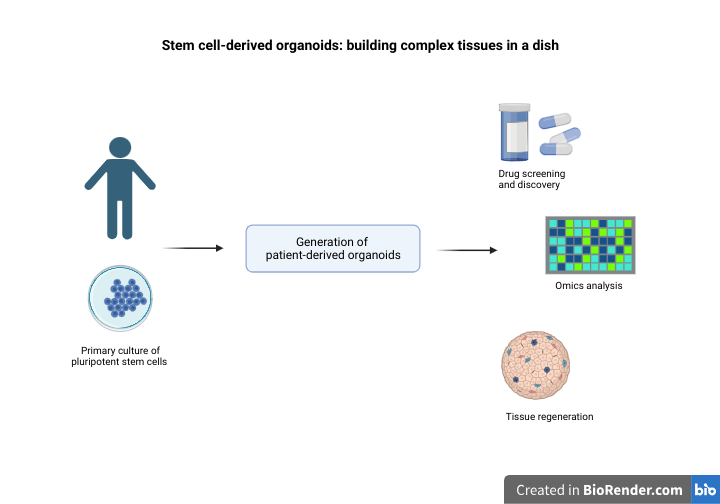
Stem cell-derived organoids: building complex tissues in a dish
In the realm of regenerative medicine and biological research, stem cell-derived organoids have emerged as miniature marvels. These tiny, three-dimensional structures, cultivated from stem cells, offer an astonishing glimpse into the intricate world of human tissue development and disease modeling. This article explores the fascinating science behind stem cell-derived organoids, their potential applications, and their transformative impact on medicine and biology (1,2).
Stem cells and organoids To understand stem cell-derived organoids, we first delve into the remarkable world of stem cells. Stem cells are undifferentiated cells with the extraordinary ability to develop into various specialized cell types. They serve as the building blocks of our bodies, playing a pivotal role in embryonic development, tissue repair, and maintenance. Organoids are, in essence, simplified, yet highly organized, versions of human organs. They are created by coaxing stem cells to self-organize into three-dimensional structures that mimic the architecture and function of specific organs or tissues. The process involves a delicate balance of biochemical cues, growth factors, and environmental conditions that guide the cells to differentiate into the desired cell types and form organ-like structures (3,4).
Challenges and future directions Despite their immense potential, stem cell-derived organoids face challenges. Replicating the full complexity of human organs remains a significant hurdle. Achieving vascularization, modeling immune responses, and scaling up production are ongoing areas of research (5).
The future of stem cell-derived organoids is exceptionally promising. Advances in biotechnology, genetic engineering, and materials science are expanding the possibilities for creating more sophisticated and functional organoids. As this technology continues to evolve, we can anticipate groundbreaking discoveries and innovative applications that will transform medicine, biology, and our understanding of human health and disease. Stem cell-derived organoids truly represent a frontier where science meets the remarkable potential for improving human lives.
Reference
1. Azar J, Bahmad HF, Daher D, Moubarak MM, Hadadeh O, Monzer A, Al Bitar S, Jamal M, Al-Sayegh M, Abou-Kheir W. The Use of Stem Cell-Derived Organoids in Disease Modeling: An Update. Int J Mol Sci. 2021 Jul 17;22(14):7667. doi: 10.3390/ijms22147667. PMID: 34299287; PMCID: PMC8303386.
2. Chinta MS, desJardins-Park HE, Wan DC, Longaker MT. “Tissues in a Dish”: A Review of Organoids in Plastic Surgery. Plast Reconstr Surg Glob Open. 2020 Apr 29;8(4):e2787. doi: 10.1097/GOX.0000000000002787. PMID: 32440447; PMCID: PMC7209840.
3. McCauley HA, Wells JM. Pluripotent stem cell-derived organoids: using principles of developmental biology to grow human tissues in a dish. Development. 2017 Mar 15;144(6):958-962. doi: 10.1242/dev.140731. PMID: 28292841; PMCID: PMC5358106.
4. Tang XY, Wu S, Wang D, Chu C, Hong Y, Tao M, Hu H, Xu M, Guo X, Liu Y. Human organoids in basic research and clinical applications. Signal Transduct Target Ther. 2022 May 24;7(1):168. doi: 10.1038/s41392-022-01024-9. PMID: 35610212; PMCID: PMC9127490.
5. Harris AR, Walker MJ, Gilbert F. Ethical and regulatory issues of stem cell-derived 3-dimensional organoid and tissue therapy for personalised regenerative medicine. BMC Med. 2022 Dec 27;20(1):499. doi: 10.1186/s12916-022-02710-9. PMID: 36575403; PMCID: PMC9795739.



